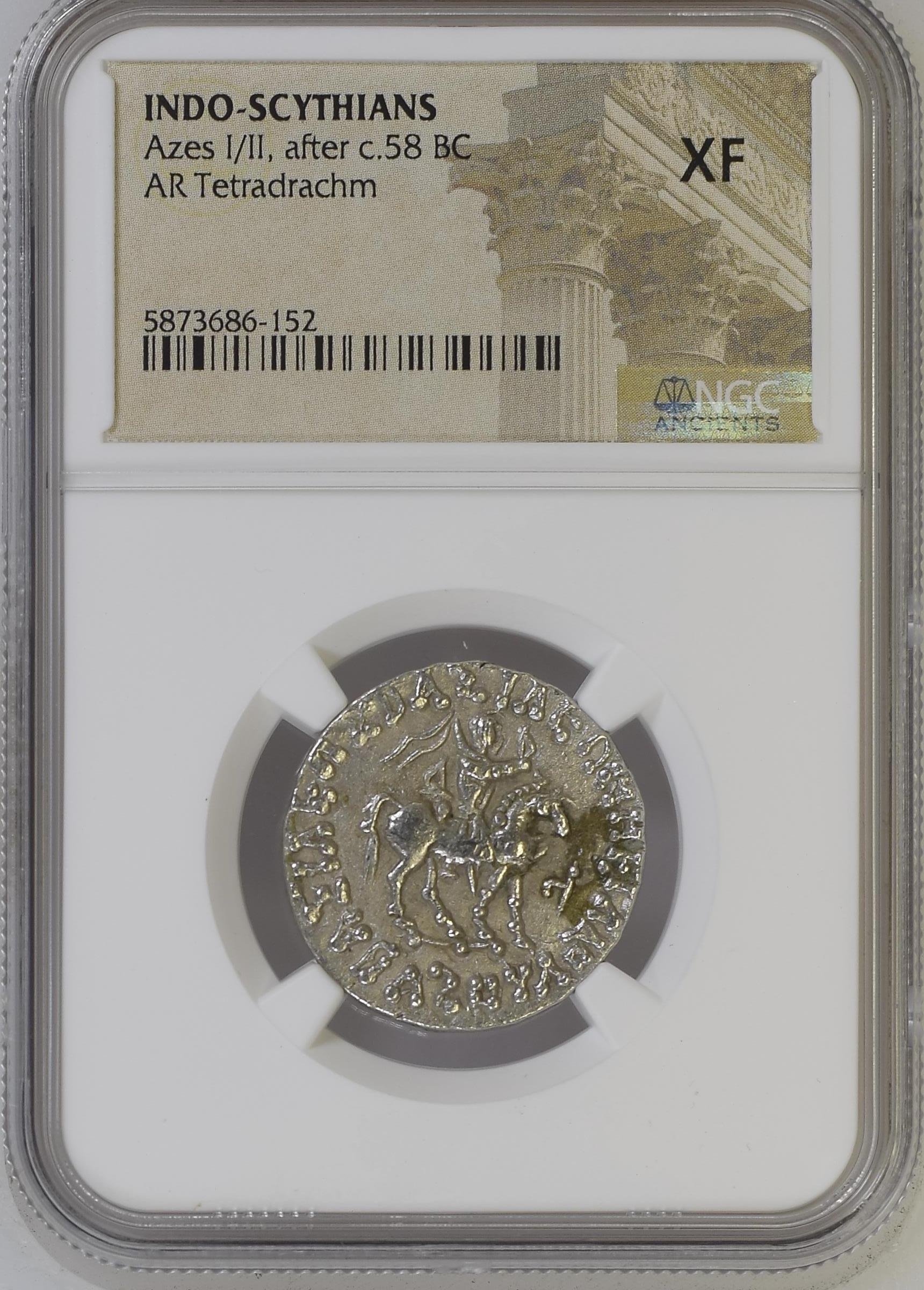 Image 1 of 4
Image 1 of 4

 Image 2 of 4
Image 2 of 4

 Image 3 of 4
Image 3 of 4

 Image 4 of 4
Image 4 of 4





Cilician Silver Stater (Large Silver Coin) from Nagidos featuring Aphrodite and Dionysus (about 2415 years ago)
This silver stater (major silver denomination) was minted around 400-385 BC in Nagidos, a city in ancient Cilicia (southern coast of modern Turkey).
Front Side: Shows Aphrodite (goddess of love) seated left, holding a phiale (shallow dish used for libations) over an altar, with Eros (god of love) standing to the right and crowning her with a wreath
Back Side: Depicts Dionysus (god of wine) standing left, holding a grape bunch on a vine and a thyrsos (staff topped with a pine cone), with the letter "A" inside a wreath to the left
Technical Details:
Denomination: Stater
Material: Silver (AR)
References: Casabonne Type 4; Lederer 25 (same obverse die); SNG BN –; SNG Levante –; BMC 12 (same obverse die)
Note: Coin was previously in a protective slab but is now loose
Historical Significance: Nagidos was one of several Greek colonies along the Cilician coast that thrived through maritime trade. This coin demonstrates the strong Greek cultural influence in this region, which was at the crossroads between the Greek and Persian worlds. The religious imagery featuring Aphrodite and Dionysus reflects the importance of these deities to the city's identity and religious practices. The high artistic quality of this coin reveals the prosperity of Cilician coastal cities during this period, when they benefited from trade networks connecting the Aegean world with the Near East. The grape imagery also suggests the economic importance of viticulture and wine production to the local economy.
This silver stater (major silver denomination) was minted around 400-385 BC in Nagidos, a city in ancient Cilicia (southern coast of modern Turkey).
Front Side: Shows Aphrodite (goddess of love) seated left, holding a phiale (shallow dish used for libations) over an altar, with Eros (god of love) standing to the right and crowning her with a wreath
Back Side: Depicts Dionysus (god of wine) standing left, holding a grape bunch on a vine and a thyrsos (staff topped with a pine cone), with the letter "A" inside a wreath to the left
Technical Details:
Denomination: Stater
Material: Silver (AR)
References: Casabonne Type 4; Lederer 25 (same obverse die); SNG BN –; SNG Levante –; BMC 12 (same obverse die)
Note: Coin was previously in a protective slab but is now loose
Historical Significance: Nagidos was one of several Greek colonies along the Cilician coast that thrived through maritime trade. This coin demonstrates the strong Greek cultural influence in this region, which was at the crossroads between the Greek and Persian worlds. The religious imagery featuring Aphrodite and Dionysus reflects the importance of these deities to the city's identity and religious practices. The high artistic quality of this coin reveals the prosperity of Cilician coastal cities during this period, when they benefited from trade networks connecting the Aegean world with the Near East. The grape imagery also suggests the economic importance of viticulture and wine production to the local economy.
This silver stater (major silver denomination) was minted around 400-385 BC in Nagidos, a city in ancient Cilicia (southern coast of modern Turkey).
Front Side: Shows Aphrodite (goddess of love) seated left, holding a phiale (shallow dish used for libations) over an altar, with Eros (god of love) standing to the right and crowning her with a wreath
Back Side: Depicts Dionysus (god of wine) standing left, holding a grape bunch on a vine and a thyrsos (staff topped with a pine cone), with the letter "A" inside a wreath to the left
Technical Details:
Denomination: Stater
Material: Silver (AR)
References: Casabonne Type 4; Lederer 25 (same obverse die); SNG BN –; SNG Levante –; BMC 12 (same obverse die)
Note: Coin was previously in a protective slab but is now loose
Historical Significance: Nagidos was one of several Greek colonies along the Cilician coast that thrived through maritime trade. This coin demonstrates the strong Greek cultural influence in this region, which was at the crossroads between the Greek and Persian worlds. The religious imagery featuring Aphrodite and Dionysus reflects the importance of these deities to the city's identity and religious practices. The high artistic quality of this coin reveals the prosperity of Cilician coastal cities during this period, when they benefited from trade networks connecting the Aegean world with the Near East. The grape imagery also suggests the economic importance of viticulture and wine production to the local economy.
Cilicia (/sɪˈlɪʃə/)[3][note 1] is a geographical region in southern Anatolia, extending inland from the northeastern coasts of the Mediterranean Sea. Cilicia has a population ranging over six million, concentrated mostly at the Cilician plain (Turkish: Çukurova). The region includes the provinces of Mersin, Adana, Osmaniye, Kilis and Hatay.
The name of Cilicia (Κιλικία) was derived from Ḫilakku (𒆳𒄭𒋃𒆪[4]), which was the name used by the Neo-Assyrian Empire to designate the western part of what would become Cilicia.[5]
You Might Also Like











